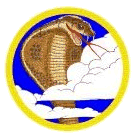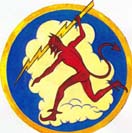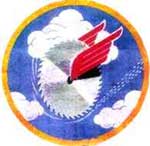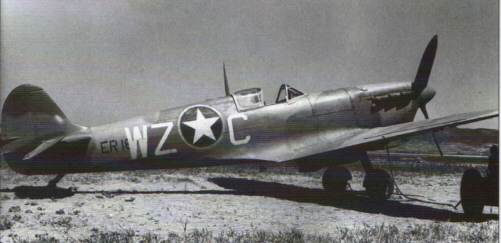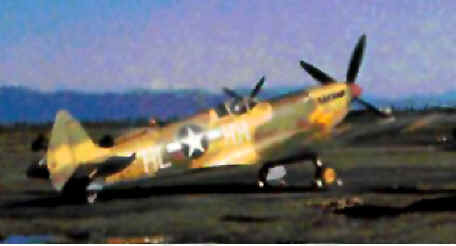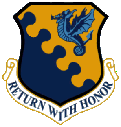
31st Fighter Group
Great website for photos and more: http://www.wwiiaircraftperformance.org/31st/31st.html
|
Squadron Insignia 1940-1942 |
|
|
|
| Squadron | 39th FS ('40-42) Cobras |
40th FS The 40th Pursuit Squadron was activated at Selfridge Field, MI on 22 December 1939 as part of the 31st Pursuit Group with the 39th and 41st Squadrons. One of the early Commanders, Captain (now Lt General, ret) Albert P. Clark, designed the first Red Devil insignia to fit on the anticipated P-40s. Later in 1941 when the squadron was under 1st Lt. (now Lt General, ret) Fred M. Dean, the Red Devil was re-designed to fit on the cockpit doors of the new P-39s which were flown on the Summer-Fall maneuvers in the south-eastern USA. In the Fall of 1941 the squadron was flying P-39s and the Red Devil was emblazoned on the doors of the aircraft. On 7 December 1941 the squadron was based at Baer Field, Fort Wayne, IN and, three days later, they were headed to Port Angeles, WA. The 31st Group was recalled to Selfridge and took half of the 40th to become the 308th Squadron. The remaining 40th cadre shipped from San Francisco for Australia and landed there on 25 February 1942. The Squadron, now designated the 40th Fighter Squadron of the 35th Fighter Group under 5th Air Force, was ordered on 2 June 1942 to Papua and began flying missions over New Guinea |
41st FS |
| Aircraft Codes: | |||
|
Squadron Insignia 1942-1945 |
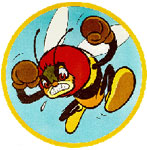 |
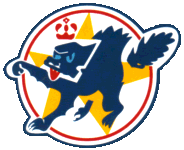 |
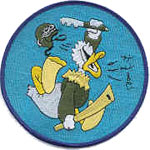 |
| Squadron | 307th FS ('42-45) | 308th FS ('42-45) |
309th FS ('42-45) The Wild Ducks |
| Aircraft Codes: | MX |
HL Lt
Hurd, one of our 308 pilots was an artist and he designed the 308th
Squadron Insignia. Many in the 308th wore them on their jackets, flight
suits. etc. The Black Cat is
a FIGHTER! The cat has a golden crown because we flew British Spitfires.
|
WZ |
| Callsign | Playboy | Gunna | Woodbine also Hobnail |
31st
Fighter Group 307th Squadron Spitfire MX-P, shot down by Allied antiaircraft
fire
over Paestum beach in Italy. Another source has Spitfire Vb MX-T, s/n JK707,
(15MU 24-2-43 76MU 10-3-43 Harpolycus 22-3-43 Casablanca 6-4-43 NWAfrica 30-4-43
31FtrGrpUSAAF Shot down by US Navy off Salerno 9-43),307th Fighter Squadron,
31st Fighter Group, operating from Gozo,
July 1943. This aircraft ended its days in September 1943, in a belly-landing on
the beach at Salerno, after having been hit by friendly fire.
Two Army Air Force fighter groups in World War II had the unique and distinct opportunity of transitioning to
and flying a famous British aircraft, the Supermarine Spitfire, throughout the Mediterranean theater. Those two groups
were the 31st (Squadrons 307th, 308th, 309th) and 52nd Fighter Groups (Squadrons 2nd, 4th, 5th), and this is their history.
Introduced to the Spitfire upon their arrival in the United Kingdom in the summer of 1942, they participated in
Operation Torch, then swept through the Mediterranean theater in support of Allied forces. Distinguishing themselves
with their performance in the Spitfire, they made major contributions to the war effort in that aircraft until they
transitioned to the P-51 Mustang in the spring of 1944
The 31st Pursuit Group, composed of a Headquarters squadron, and the 39th, 40th, and 41st Pursuit Squadrons was formed on February 1, 1940 at Selfridge Field, Michigan. They were initially equipped with P-39s. In January 1942 the 39th, 40th and 41st were transferred to the 35th PG and the 307th, 308th, and 309th Pursuit Squadrons were formed in their place to comprise the 31st. These three squadrons were equipped with the P-40B for three months then again re-equipped with the P-39.
More on how the Squadrons evolved with some in Australia.
In June 1942 the Group's personnel were shipped to England with Headquarters, the 307th, and the 308th based at Atcham. The 309th was based at High Ercall. All three squadrons received Spitfire Vbs and assigned the squadron codes MX (307th), HL (308th), and WZ (309th). On August 1st the Group was deemed ready for action and the squadrons moved closer to the fighting, with the 307th moving to Biggin Hill, the 308th to Kenley, and the 309th to Westhampnett. Under RAF control, the squadrons sent sweeps to France during the first two weeks of August, took part in Circus 204 to Lille on the 17th and the big Dieppe Operation on the 19th. Group claims for the Dieppe Operation were 2 destroyed, 3 probable, and 1 damaged for the loss of 8 Spitfires. By the end of August the Group had all moved to the Westhampnett area and through September and early October participated in the usual patrols and Circuses of the time. The Circus operations were focused on Le Harve and Abbeville. On September 14 the 31st was transferred from the VIII AF to the XII AF. On Oct 13, 1942 the Group was declared non-operational and by the 23rd was on board ships bound for North Africa.
Source for following: http://www.web-birds.com/
The 31st Fighter Group was on overseas duty for thirty-seven months. During
that time, it received two Presidential citations; it participated in twelve
campaigns including Algeria-French Morocco, Tunisia, Sicily, Naples-Foggia,
Rome-Arno, Po Valey, North Appenines, Southern France, Northern France,
Balkans, Rhineland and Air Offensive Europe.
| Air Forced Assigned To: | 8th AF (May '42 -Oct '42) | |
| 12th AF (Oct '42 - April '44) | ||
| 15th AF (April '44 - end WWII) | ||
| Stations Flown From: |
Atcham, England (June '42 -Aug '42) 28 Jun - Many accidents are being registered. The 308th cracked up four planes today, one turning completely over in a wheat field, but nobody was injured 29 Jun - Lieut. Giacomini of 308 was killed in a crash today, apparently due to mechanical failure; he died on way to hospital. 9 Jul - Two planes cracked up. 10 Jul - Two Spits collided in mid-air today, but nobody was hurt. 14 Jul - Officers meeting in the morning. In the past 16 days, 21 planes have been destroyed or badly damaged, most of them by 308 Squadron. That's too many, and due to carelessness, says Col. Hawkins. 18 Jul - Lieut. Kerr of 309 was killed last night during an oxygen hop. It appeared that something went wrong with his oxygen and he blacked out, went straight in.
SUNDAY, 26 JULY 1942 EUROPEAN THEATER OF OPERATIONS (ETO, 8th Air Force): Lieutenant Colonel Albert P Clark, Executive Officer of the 31st Fighter Group, is shot down while flying with the 412 Squadron (Royal Canadian Air Force), on a sweep over France, thus becoming the first 8th Air Force fighter pilot to be shot down in the ETO; he survives and is taken prisoner by the Germans. |
|
|
Westhampnet, England (Aug '42 - Nov '42) SATURDAY, 1 AUGUST 1942, EUROPEAN THEATER OF OPERATIONS (ETO, 8th Air Force):HQ 31st Fighter Group and 307th, 308th and 309th Fighter Squadrons move from Atcham to Westhampnett, Biggin Hill, Kenley and Westhampnett, England respectively with Spitfire Mk Vs. WEDNESDAY, 5 AUGUST 1942, ETO (8th AF): VIII Fighter Command dispatches its first mission-11 Spitfire Mk Vs of the 31st Fighter Group on a practice run over France. TUESDAY, 11 AUGUST 1942, ETO (8th AF): Referring to Operation TORCH (plans for the invasion of N Africa in Nov 42), Major General Carl Spaatz informs General Henry H "Hap" Arnold that, in his opinion, the UK remains the only base from which air supremacy over Germany can be established. WEDNESDAY, 12 AUGUST 1942, ETO (8th AF): 31st Fighter Group at Westhampnett, England with Spitfire Mk Vs, is declared fully operational and ready for combat operations under Royal Air Force (RAF) control until it gains enough experience to be able to fight as a group; this is first US fighter unit in the UK to reach this operational status. WEDNESDAY, 19 AUGUST 1942, ETO (8th AF): Mission 2: 22 of 24 B-17s bomb Abbeville/Drucat Airfield, France at 1032-1040 hours; 3 B-17s are damaged; 6 B-17s fly a diversion and 2 airmen are WIA. This mission is flown to occupy the Luftwaffe and prevent them from opposing an invasion by over 5,000 Allied troops, mostly Canadians, who raid Dieppe, France. 123 Spitfire Mk Vs of the 31st Fighter Group support the raid on Dieppe and claim 1-1-5 Luftwaffe aircraft with the loss of 8 Spitfires (4 pilots are MIA); 2d Lieutenant Samuel F Junkin Jr of the 309th Fighter Squadron, 31st Fighter Group, flying a Spitfire Mk V in support of the amphibious raid on Dieppe, shoots down a German fighter, this being the first aerial victory won by an 8th Air Force fighter pilot flying from the UK. Units arriving in England from the US, (Lieutenant Samuel F. Junkin of the 309 FS became the first 31 FG pilot to down an enemy plane on a mission with 11 other Spits of his squadron. They took off from Westhampnett for a rendezvous with RAF 130 and 131 Squadrons. After crossing the Channel to the Dieppe beachhead, they were attacked by 25 FockeWulf Fw-190s (FW-190/FW). During the ensuing dogfight, Lieutenant Junkin was one-versus-one with a FW, which he managed to shoot down before he was subsequently attacked by a second FW. Wounded in the shoulder by cannon fire, he momentarily passed out, but regained consciousness just above sea level. He climbed to 1,000 feet where he planned to bail out, having to break through his stuck canopy before he managed to get out at an altitude of 600-700 feet. Rescued by an Allied torpedo boat, he was transferred to another ship which had also picked up Lieutenant Collins, another Spitfire pilot who had been shot down. When it was all over, the 31 FG had flown 123 sorties for the day. The inexperienced group lost eight Spitfires, with seven more damaged. Lieutenant Lewis P. Wells was killed, Lieutenant Robert G. Wright missing, with three other pilots later reported as prisoners of war. Lieutenant Junkin had scored the unit's first kill, however, along with a kill by a pilot in the 307 FS. Captain Hill was credited with a probable, along with Major Harrison Thyng and Lieutenant J. H. White, plus two claims by the 31 FG for enemy aircraft damaged): HQ 1st Bombardment Wing at Brampton Grange; 353d and 419th Bombardment Squadrons (Heavy), 301st Bombardment Group (Heavy), at Chelveston with B-17s (first mission is 2 Oct). 2d, 4th and 5th Fighter Squadron, 52d Fighter Group arrive at Eglinton, Co Derry, Ireland from the US (squadrons will be equipped with Spitfire Mk Vs and 2d and 4th Fighter Squadrons will fly their first mission on 27 Aug; 5th Fighter Squadron will not fly missions). MONDAY 24 AUGUST 1942, ETO (8th AF): Mission 5: 12 of 12 B-17s bomb the shipyard of Ateliers et Chantiers Maritime de la Seine at Le Trait, France; 3 B-17s are damaged and 5 airmen are WIA. Major General Carl Spaatz reports the the RAF attitude towards US daylight precision bombing seems to be changing from one of skepticism to one of tentative approval. Unit moves in England: HQ 6th Fighter Wing from Bushey Hall to Atcham; HQ 1st Fighter Group and 71st Fighter Squadron from Goxhill to Ibsley with P-38s (first mission is 1 Sep); 307th Fighter Squadron, 31st Fighter Group, from Biggin Hill to Merston. TUESDAY, 25 AUGUST 1942, ETO (8th AF): Units of the Provisional Troop Carrier Command, organized in the UK on 31 Jul pending arrival of the VIII Troop Carrier Command, are transferred to the VIII Ground Air Support Command after plans to organize the VIII Troop Carrier Command are abandoned. 308th Fighter Squadron, 31st Fighter Group, moves from Kenley to Westhampnett, England with Spitfires. TUESDAY, 8 SEPTEMBER 1942, EUROPEAN THEATER OF OPERATIONS (ETO, 8th Air Force): The "Joint British American Directive on Day Bomber Operations Involving Fighter Cooperation" is issued; worked out between Major General Carl Spaatz and the RAF, it consigns night bombing to the RAF and day bombing to the Eighth Air Force; the purpose is to achieve continuity in the bombing offensive and secure RAF fighter support for US bombers; General Spaatz orders all tactical operations to give way to activity in support of Operation TORCH (plan for Allied landings in N and NW Africa in Nov 42); processing of units of the newly created Twelfth Air Force destined for N Africa takes priority over combat operations for the present. In England, HQ 3d Photographic Group arrives at Membury from the US; 342d and 414th Bombardment Squadrons (Heavy), 97th Bombardment Group (Heavy), move from Grafton Underwood to Polebrook with B-17s. MONDAY, 14 SEPTEMBER 1942, EUROPEAN THEATER OF OPERATIONS (ETO) 8th Air Force: After the transfer of the combat unit to the Twelfth Air Force (see below), the combat units assigned to the Eighth are: HQ 3d Photographic Group and 5th, 12th, 13th and 14th Photographic Squadrons and 15th Photographic Mapping Squadron with F-4s, F-5s and B-17Fs; HQ 4th Fighter Group and 334th, 335th and 336th Fighter Squadrons at Steeple Morden with Spitfire Vs; HQ 44th Bombardment Group (Heavy) and 66th, 67th and 68th Bombardment Squadrons (Heavy) at Cheddington with B-24s; HQ 67th Observation Group and 12th, 107th, 109th and 153d Observation Squadrons at Membury with no aircraft; HQ 91st Bombardment Group and 322d, 323d, 324th and 401st Bombardment Squadrons (Heavy) at Kimbolton with B-17Fs; HQ 92d Bombardment Group (Heavy) and 325th, 326th, 327th and 407th Bombardment Squadrons (Heavy) at Bovingdon with B-17Fs; HQ 93d Bombardment Group (Heavy) and 328th, 329th, 330th and 409th Bombardment Squadrons (Heavy) at Alconbury with B-24Ds; HQ 303d Bombardment Group (Heavy) and 358th, 359th, 360th and 427th Bombardment Squadrons (Heavy) at Molesworth with B-17Fs; HQ 305th Bombardment Group (Heavy) and 364th, 365th, 366th and 422d Bombardment Squadrons (Heavy) at Grafton Underwood with B-17Fs; and HQ 306th Bombardment Group (Heavy) and 367th, 368th, 369th and 423d Bombardment Squadrons (Heavy) at Thurleigh with B-17Fs. Twelfth Air Force: HQ Twelfth AF, XII Fighter Command, XII Air Force Services Command, and XII Bomber Command are attached to corresponding units of the Eighth AF in the UK; The Eighth subsequently handles the buildup of the Twelfth by assigning a large number of its own units to the new AF (appropriately dubbed JUNIOR) and supervises its training. The following combat units are transferred from the Eighth to Twelfth Air Force: HQ 1st Fighter Group and 27th, 71st and 94th Fighter Squadrons at Ibsley and High Ercall with P-38Fs; HQ 14th Fighter Group and 48th and 49th Fighter Squadrons at Atcham with P-38Fs; HQ 31st Fighter Group and 307th, 308th and 309th Fighter Squadrons at Westhampnett with Spitfire Vs; HQ 52d Fighter Group and 2d, 4th and 5th Fighter Squadrons at Goxhill with Spitfire Vs; HQ 60th Troop Carrier Group and 10th, 11th, 12th and 28th Troop Carrier Squadrons at Aldermaston with C-47s; HQ 64th Troop Carrier Group and 16th, 17th, 18th and 35th Troop Carrier Squadrons at Ramsbury with C-47s; HQ 97th Bombardment Group (Heavy) and 340th, 341st, 342d and 414th Bombardment Squadrons (Heavy) at Polebrook with B-17Fs; HQ 301st Bombardment Group (Heavy) and 32d, 352d, 353d and 419th Bombardment Squadrons at Chelveston with B-17Fs; and 15th Bombardment Squadron (Light) at Podington with DB-7s. THURSDAY, 22 OCTOBER 1942, EUROPEAN THEATER OF OPERATIONS (ETO), Twelfth Air Force: HQ Twelfth AF, the 307th Fighter Squadron, 31st Fighter Group, and the 437th and 439th Bombardment Squadrons (Medium), 319th Bombardment Group (Medium), begin the move from the UK to N Africa. FRIDAY, 23 OCTOBER 1942, EUROPEAN THEATER OF OPERATIONS (ETO) Twelfth Air Force: The 27th and 71st Fighter Squadrons, 1st Fighter Group, and 308th and 309th Fighter Squadrons, 31st Fighter Group, begin the move from the UK to N Africa (The 31st and 52nd Fighter Groups were both to participate, and were transferred to Twelfth Air Force, XII Fighter Command in October. Due to the range limitations of the Spitfires, the aircraft were to be left behind. New Spits were to be assembled from their crates at Gibraltar once the two groups arrived. On 21 and 23 October respectively, the 52 FG and 31 FG departed the United Kingdom by ship for Gibraltar and Algeria) |
||
|
Tafaraoui, Algeria (Nov '42) SATURDAY, 7 NOVEMBER 1942, NW AFRICA (Twelfth Air Force): The invasion of N Africa (Operation TORCH) begins. In French Morocco, C-47s of the 60th Troop Carrier Group attempting to land troops at La Senia Airfield find the French unexpectedly hostile and have several aircraft shot down by fighters and AA; several other C-47s are damaged when trying to land on the dry lake bed of Sebkra d'Oran. Spitfires of the 31st Fighter Group, flying from Gibraltar into Tafaraoui Airfield, Algeria during the afternoon of D-Day, claim 3 hostile French fighters destroyed. In Algeria, the following units arrive at Tafaraoui Airfield from the UK: HQ XII Fighter Command, HQ 31st Fighter Group, HQ 60th Troop Carrier Group and 10th, 11th and 12th Troop Carrier Squadrons with C-47s, air echelon of 2d, 4th and 5th Fighter Squadrons, 52d Fighter Group with Spitfires, and the 308th and 309th Fighter Squadrons, 31st Fighter Group, with Spitfires; the 71st Fighter Squadron, 1st Fighter Group, arrives at St Leu from the UK with P-38s. In French Morocco during Nov 42, HQ 5th Bombardment Wing and HQ 7th Fighter Wing arrive at Casablanca from the US (After arriving at Gibraltar, desert camouflaged Spit Vs were assembled, equipped with specially designed air intakes for desert operations. The word was "go" on 8 November 1942 for flights into Algeria behind the invasion force. Departures were staggered, and the 31 FG launched for Oran in the afternoon, the pilots of the group flying Spitfires from Gibraltar to Algeria on 8 Nov 1942 and the ground echelon landing at Arzeu beach the same day, ith the 52 FG to follow several hours later. With known Vichy French aircraft in the area, the first Spits of the 31 FG led by Colonel John R. Hawkins arrived overhead Tafaraoui (Figure 2) aerodrome outside Oran for landings. Colonel Hawkins landed, however his wingman, Lieutenant Joe C. Byrd, Jr., was shot down and killed by a French Dewoitine 520. The Dewotine, misidentified as a British Hawker Hurricane, attacked just as Byrd crossed the airfield boundary with his gear and flaps down. The remaining airborne Spitfires gave chase, destroying three of the four Dewotines. Major Thyng and Lieutenants Carl W. Payne and Charles Kenworthy were each credited with one destroyed enemy aircraft) SUNDAY, 10 JANUARY 1943, WESTERN MEDITERRANEAN (Twelfth Air Force): The 308th Fighter Squadron, 31st Fighter Group with Spitfire Mk Vs begins operating from Casablanca, French Morocco instead of Tafaraoui, Algeria to provide protection for the Casablanca Conference between Churchill and Roosevelt. SATURDAY, 30 JANUARY 1943, WESTERN MEDITERRANEAN (Twelfth Air Force):, With the conclusion of the Casablanca Conference, the 308th Fighter Squadron, 31st Fighter Group, which has been operating its Spitfire Mk Vs from Casablanca, returns to its base at Tafaraoui, Algeria. MONDAY, 9 NOVEMBER 1942, NW AFRICA (Twelfth Air Force): In Algeria, Spitfires of the 31st Fighter Group attack and halt an armored column moving N toward Tafaraoui, and also attack artillery and AA batteries SE of Tafaraoui and along the coastal road; at 1605 hours, Major General James H Doolittle, Commanding General Twelfth AF, arrives in Algeria from Gibraltar by B-17, escorted by 12 Spitfires from the 52d Fighter Group; HQ Twelfth AF arrives in Algeria from the UK; HQ 52d Fighter Group arrives at Tafaraoui from the UK; the 27th Fighter Squadron, 1st Fighter Group arrives at St Leu with P-38s; the 307th Fighter Squadron, 31st Fighter Group arrives at Tafaraoui with Spitfires. In French Morocco, HQ XII Air Support Command arrives from the US; HQ 68th Observation Group and the 16th and 122d Observation Squadron arrive at Casablanca and Fedala respectively from the US with A-20s and P-39s. |
||
|
La Senia, Algeria (Nov '42 - Feb '43) THURSDAY, 12 NOVEMBER 1942, NW AFRICA (Twelfth Air Force), the 307th Fighter Squadron, 31st Fighter Group, moves from Tafaraoui to La Senia with Spitfires. SATURDAY, 14 NOVEMBER 1942, NW AFRICA (Twelfth Air Force):the 309th Fighter Squadron, 31st Fighter Group moves from Tafaraoui to La Senia with Spitfires. TUESDAY, DECEMBER 8, 1942, WESTERN MEDITERRANEAN (Twelfth Air Force): In Algeria, fighters of the 31st and 52d Fighter Groups patrol in the Oran-La Senia-Tafaraoui area. Weather prevents operations of all bomber and fighter units in eastern Algeria. SUNDAY, 7 FEBRUARY 1943, WESTERN MEDITERRANEAN (Twelfth Air Force) HQ 31st Fighter Group transfers from La Senia, Algeria to Thelepte, Tunisia. The 307th Fighter Squadron with Spitfire Mk Vs, assigned to the 31st, transfers from Maison Blanche, Algeria to Thelepte |
||
|
Thelepte, Tunisia (Feb '43) SATURDAY, 6 FEBRUARY 1943, WESTERN MEDITERRANEAN (Twelfth Air Force): The 308th and 309th Fighter Squadrons, 31st Fighter Group with Spitfire Mk Vs transfer from Tafaraoui, Algeria and La Senia, Algeria respectively to Thelepte, Tunisia. |
||
|
Tebessa, Algeria (Feb '43) WEDNESDAY, 17 FEBRUARY 1943, WESTERN MEDITERRANEAN (Twelfth Air Force): The Twelfth Air Force and other organizations of the Allied Air Force are transferred to the North African Air Force (NAAF) which supplants the Allied Air Force. NAAF, in turn, becomes part of the Mediterranean Air Command (MAC), a new air command which comes into existence on this date with RAF Air Chief Marshall Arthur Tedder as commander. MAC also includes the RAF Middle East Air Command (later RAF, Middle East) and the RAF Malta Air Command (later RAF, Malta). The Commanding General of NAAF is General Carl Spaatz, USAAF. The two airfields at Thelepte, with 124 operational aircraft on the ground, some are abandoned because of the German advance. Eighteen unflyable aircraft are burned after 60,000 gallons (227,100 liters) of aviation fuel are poured on them. HQ 31st Fighter Group transfers from Thelepte, Tunisia to Youks-les- Bains, Algeria. The group's 307th, 308th and 309th Fighter Squadrons with Spitfire Mk Vs transfer from Thelepte to Tebessa, Algeria. |
||
|
Youks-les-Bains, Algeria (Feb '43) WEDNESDAY, 17 FEBRUARY 1943, WESTERN MEDITERRANEAN (Twelfth Air Force) HQ 31st Fighter Group transfers from Thelepte, Tunisia to Youks-les- Bains, Algeria. SUNDAY, 21 FEBRUARY 1943, WESTERN MEDITERRANEAN (North African Air Force), HQ 31st Fighter Group transfers from Tebessa, Algeria to Youks-les- Bains, Algeria. The 308th Fighter Squadron assigned to the group transfers its Spitfire Mk Vs from Tebessa to Canrobert, Algeria. MONDAY, 22 FEBRUARY 1943, The 307th and 309th Fighter Squadrons, 31st Fighter Group with Spitfire Mk Vs transfer from Tebessa, Algeria to Youks-les-Bains, Algeria. |
||
|
Kalaa Djerda, Tunisia (Feb '43 - March '43) THURSDAY, 25 FEBRUARY 1943, HQ 31st Fighter Group and its 307th Fighter Squadron with Spitfire Mk Vs transfer from Youks-les-Bains, Algeria to Kalaa Djerda, Tunisia. The 308th Fighter Squadron also with Spitfire Mk Vs transfers from Canrobert, Algeria to Kalaa Djerda. FRIDAY, 26 FEBRUARY 1943, The 309th Fighter Squadron, 31st Fighter Group with Spitfire Mk Vs transfers from Youks-les-Bain, Algeria to Kalaa Djerda, Tunisia. THURSDAY, 11 MARCH 1943, HQ 31st Fighter Group and it's 307th, 308th and 309th Fighter Squadrons with Spitfire Mk V's transfer from Kalaa Djerda, Tunisia to Thelepte, Tunisia. |
||
|
Thelepte, Tunisia (March '43 - April '43) WEDNESDAY, 7 APRIL 1943, HQ 31st Fighter Group and it's 307th, 308th and 309th Fighter Squadrons with Spitfires transfer from Thelepte, Tunisia to Djilma, Tunisia. |
||
|
Djimla, Tunisia (April '43) MONDAY, 12 APRIL 1943, HQ 31st Fighter Group and it's 307th, 308th and 309th Fighter Squadrons with Spitfires transfer from Djilma, Tunisia to Le Sers, Tunisia. |
||
|
Le Sers, Tunisia (April '43 - May '43) MONDAY, 17 MAY 1943, WESTERN MEDITERRANEAN (Northwest African Air Force), The 309th Fighter Squadron Spitfires), 31st Fighter Group, transfers with Spitfires from Le Sers, Tunisia to Korba, Tunisia. |
||
|
Korba, Tunisia (May '43 - June '43) THURSDAY, 20 MAY 1943, WESTERN MEDITERRANEAN (Northwest African Air Force),The 308th Fighter Squadron, 31st Fighter Group transfers with Spitfires from Le Sers, Tunisia to Korba, Tunisia. ( On 10 June, the squadrons were supporting bombers attacking Pantelleria, flying 72 sorties on 7 missions, in addition to 2 scrambles against enemy aircraft. Although one Spitfire and pilot were lost, they successfully shot down 12 enemy aircraft, plus 3 more probables. The one Spitfire lost, a case of mistaken identity, was flown by Lieutenant Gooding.'' On that mission, he and his wingman became separated from the rest of the group and returned to base alone. Approximately 20 miles from their field, they observed three P-40s closing from behind, as if to join up, and one of them shot down Gooding. Lieutenant Gooding entered a spin and crashed into the sea. Ground forces occupied Pantelleria, an island surrendered to the Allies from aerial bombardment, with no opposition on 11 June 1943. The 52 FG was flying cover for much of the operation as well as the 31 FG. The 52 FG remained at their field in Tunis, where the Luftwaffe continued to make attacks on the ports, but the 31 FG moved to a strip on Gozo, a neighboring island to Malta, south of Sicily on 30 June (Figure 3). The move did not go smoothly, though, as Lieutenant Stevens of the 308 FG was missing from the flight. One 309 FS Spit crashed on landing, but the pilot wasn't hurt. Lieutenant Fardalla of the 308 FS then crashed into the wreckage when he landed, killing three British ground personnel and seriously injuring himself.) |
||
|
Gozo (June '43 - July '43) Read about Gozo a very under documented airstrip on an island by Malta: http://worldatwar.net/chandelle/v4/v4n1-2/gozo.html WEDNESDAY, 30 JUNE 1943, WESTERN MEDITERRANEAN (Northwest African Air Force), HQ 31st Fighter Group and it's 307th and 308th Fighter Squadrons transfer with Spitfires from Korba, Tunisia to Gozo Island, Malta. SATURDAY, 3 JULY 1943, The 309th Fighter Squadron, 31st Fighter Group transfers with Spitfires transfers from Korba, Tunisia to Gozo Island, Malta. (The next campaign was the invasion of Sicily which began on 10 July 1943. A large armada of over 300 ships was covered by the 31 FG. The landings at Gela, Sicily went relatively unhampered. The group flew patrols continuously from about 0430 until 2200. Later missions required flares for landing. Only one enemy 4-ship was observed all day, and it was too far away for anyone to engage. The next couple of days brought some air activity, however, as four enemy fighters and three enemy bombers were destroyed on the 11th. An additional fighter was destroyed the next day before the 31 FG moved to Ponte Olivo on the 13th, an airfield located in Sicily. The group didn't remain there long either, as on the 21st, it moved to Agrigento aerodrome. The 307 FS relocated to a Palermo aerodrome, and eventually all squadrons regrouped at Termini by early August, operating from two aerodromes called Termini East and Termini West) |
||
|
Ponte Olivo, Sicily (July '43) TUESDAY, 13 JULY 1943, WESTERN MEDITERRANEAN (Northwest African Air Force), HQ 31st Fighter Group and it's 309th Fighter Squadron transfer with Spitfires from Gozo Island, Malta to Ponte Olivo, Sicily. WEDNESDAY, 14 JULY 1943, WESTERN MEDITERRANEAN (Northwest African Air Force), The 307th and 308th Fighter Squadrons, 31st Fighter Group, transfer with Spitfires from Gozo Island, Malta to Ponte Olivo, Sicily. |
||
|
Agrigento, Sicily (July '43 - Aug '43) MONDAY, 19 JULY 1943. WESTERN MEDITERRANEAN (Northwest African Air Force) During the night of 18/19 Jul, Wellingtons drop over 800,000 leaflets on Rome, Italy. Northwest African Tactical Air Force (NATAF) light bombers attack Catania, Sicily. During the following day, about 150 Northwest African Strategic Air Force (NASAF) B-17's bomb the Rome, Italy railroad yards; B-25's and B-26's hit nearby Ciampino Airfield, Italy; P-40's bomb rail facilities in the Alcamo, Sicily area; and NATAF A-36's attack trains and motor transport in W Sicily. On the ground in Sicily, the US Seventh Army continues to push N and NW while the British Eighth Army's 13 Corps still faces firm resistance near Catania. The 111th Reconnaissance Squadron (Fighter), 68th Reconnaissance Group, transfers with P-51's from Ponte Olivo, Sicily to Gela, Sicily. The 308th Fighter Squadron, 31st Fighter Group, transfers with Spitfires from Ponte Olivo, Sicily to Agrigento, Sicily. WEDNESDAY, 21 JULY 1943, WESTERN MEDITERRANEAN (Northwest African Air Force), HQ 31st Fighter Group transfers from Ponte Olivo, Sicily to Agrigento, Sicily. The 307th and 309th Fighter Squadrons, 31st Fighter Group, transfer with Spitfires from Ponte Olivo, Sicily to Agrigento, Sicily. TUESDAY, 27 JULY 1943, The 307th Fighter Squadron, 31st Fighter Group, transfers from Agrigento, Sicily to Palermo, Sicily with Spitfires. |
||
|
Termini, Sicily (Aug '43 - Sept '43) SUNDAY, 1 AUGUST 1943, WESTERN MEDITERRANEAN (Northwest African Air Force):, The 307th Fighter Squadron, 31st Fighter Group, transfers from Palermo to Termini, Sicily with Spitfires. (Neither group 52nd and 31st, saw many big aerial engagements at this time. One exception involved the 31 FG on 8 August while covering landing operations at Cap Orlando. On that day, pilots encountered 16 to 20 FWs and MEs attacking Allied shipping. Three FWs were destroyed, one damaged, while Captain Williams was wounded by a 20-millimeter cannon shell in his neck and back. The 11th of August produced three kills for the 31 FG. With the fall of Messina, hostilities in Sicily effectively ceased. Both groups then had a well-deserved rest with few operational missions or scrambles. This lasted until September.) |
||
|
Milazzo, Sicily (Sept '43) The invasion of the Italian mainland began on 3 September 1943. The 31 FG was heavily involved. The 52 FG was located in Sicily for September and October, but was out of range of most of the Axis airfields, and saw little activity. The game plan on the ground was for the Eighth Army to cross the Strait, of Messina and land on the "toe" of Italy, while at the same time the Fifth Army would beach at Salerno, south of Naples. The day the forces landed in Italy, the Italians surrendered; however, the Germans didn't, and heavy fighting continued |
||
|
Montecorvino, Italy (Sept '43 - Oct '43) The 31 FG supported the landing at Salerno, operating out of Milazzo, a field on the north coast of Sicily. Pilots flew support missions for the invasion, but encountered few enemy aircraft. The group remained there only a short time before moving on 20 September to Monte Corvino aerodrome on the Italian mainland. There it found numerous enemy aircraft left behind by the Germans, most in pretty bad shape, although some were flyable. Living conditions improved significantly, as the group was housed in buildings for the first time since February. It was a nice change from tents |
||
|
Pomigliano, Italy (Oct '43 - Jan '44) Lieutenant Colonel Charles M.- McCorkle, who had replaced Lieutenant Colonel Frank Hill as 31 FG commander when Hill returned to the States, scored his first kill on 30 September just before the bad weather began to affect his group in early October. Although the 31 FG, too, flew little because of heavy rains, that did not stop it from moving to another airfield, this time to Pomigliano in Italy on 14 October 1943. For most of the month, the pilots flew routine patrols, escort missions, and tighter sweeps, some in the Naples area November, the 31 FG was starting to face renewed resistance from the Luftwaffe in Italy. There were numerous encounters throughout the month, resulting in seven enemy aircraft destroyed, one probably destroyed, and seven damaged. There were also four losses: Lieutenant Frost of the 308 FS on 5 November; Lieutenant Mann of the 307 FS on 18 November; Lieutenant Van Natta on the l9th; and Flying Officer Shenberger, a British pilot with the 309 FS. on 24 November. Of interest to the 31 FG was a visit by General Arnold and Lieutenant General Spaatz on the 10th of December. General Arnold, among other things, presented a Distinguished Flying Cross to Lieutenant Weissmueller. In passing conversation afterwards, Lieutenant Weissmueller got into hot water with the general by making a comment about how he thought the Spitfire was the best airplane in the world |
||
|
Castel Volturno, Italy (Jan '44 - April '44) The 31 FG was heavily engaged with Luftwaffe fighters and bombers early in January. Colonel McCorkle destroyed two enemy aircraft by the end of the first week, along with the group downing one and damaging three others. .The fighting was similar to the high level of activity that had occurred in Tunisia (3:44). On the l9th, the group moved to Castel Volturno, Italy (Figure 3), a steel-plank strip near the mouth of the Volturno River. From there, closer than ever to the enemy, air activity increased, and the group flew air cover for the amphibious landings at the Anzio-Nettuno area (Figure 3), southwest of Rome. On that day, Colonel McCorkle gained his fourth victory, and relates a story about one 31 FG pilot who had to make a forced landing a few days later at Anzio: "One of my fellas was shot down over Anzio beachhead, Major Thorsen, one of my squadron commanders. He had to force land on the beachhead, and as he was going down with his engine puffing smoke and pouring oil, and looking for a place to set down, for some reason he didn't want to bail out. An ME-109 pulled up alongside him, skidded down to his speed, or approximately that in sort of a slip, and saw that he was going to have to land, and saluted him, and flew away, rather than shooting at him. This is the last piece of chivalry I ever heard of in air combat By the end of the month of January, the Luftwaffe and enemy ground forces had taken a beating, although they had made their impression among both groups, too. Between the 31 FG and 52 FG, a total of 16 Spitfires had been lost Like many previous months, February was an active month for both groups. On the 1st, the 31 FG moved the 307 FS forward to Nettuno to operate out of a landing strip there. Under constant attack and artillery shelling, they pulled out two weeks later, but not before four Spitfires had been destroyed on the ground. Several events of significance occurred during the month, the first being Colonel McCorkle's fifth kill, an ME-109 on 6 February, to make him an ace (3:64). On the 13th, two 309 FS members were scrambled by a controller to intercept two bandits, which they did, and promptly shot down two FW-190s. Typical of a confident fighter pilot, Lieutenant Fawcett called the controller on the radio to say, "You know the two bandits you reported, well, they were here (23:--). Another ace was produced on 22 February when Lieutenant Leland P. Molland destroyed two ME-109s on an Anzio beachhead patrol. Also on that date, Lieutenant Hackbarth was hit, and went down streaming glycol and in flames. Attacked by three ME-109s as he was going down, the attack was thwarted by Lieutenant Brown, who dove on the enemy aircraft even though he was out of ammunition. On the humane side of war, a story reached 31 FG Headquarters on the 27th from the beachhead. German forces had returned to American forces the bodies of Lieutenants Haberle and Comstock, pilots that had been killed on 28 January and 24 February, respectively. Both men were buried at Nettuno For the 31 FG, March would be the last month flying Spitfires. On the 11th, Colonel McCorkle and Lieutenant Meador brought in the first two P-51B aircraft. During a mock dogfight over the field on the 14th, Colonel McCorkel in a P-51 paired up against Lieutenant Williams in a Spitfire IX. The Spitfire completely outmaneuvered the new Mustang. On 21 March, Lieutenant Richard F. Hurd of the 308 FS destroyed two ME-109s to become the last Spitfire ace before the 31 FG was taken off operational status to transition to the P-51. Colonel McCorkle did get permission for a farewell 36-ship fighter sweep over Rome on the 29th. For the most part uneventful, 20 FW-190s were intercepted by one 4-ship of Spits, forcing the enemy to Jettison their bombs. Lieutenant Emery destroyed one of the FWs, the last enemy aircraft downed by a 31 FG Spitfire |
||
|
San Servo, Italy (2 April '44 - March '45) On 1 April 1944, the 31 FG was placed under the command of Fifteenth Air Force (15 AF) for long-range bomber escort. Moving to a new airfield the next day, San Severo aerodrome near Foggia, Italy, the group continued transition training in earnest. On the 16th of that month, they flew their first P-51 combat mission, escorting B-24 bombers over Turnu-Severin in Rumania |
||
| Mondolfo, Italy (March '45 - end WWII) | ||
| Campaigns Flown in: | Air Combat, EAME Theatre | |
| Air Offensive, Europe | ||
| Algeria-French Morocco | ||
| Tunisia | ||
| Sicily | ||
| Naples-Foggia | ||
| Anzio | ||
| Rome-Arno | ||
| Normandy | ||
| Northern France | ||
| Southern France | ||
| North Appines | ||
| Rhineland | ||
| Central Europe | ||
| Po Valley | ||
| Awards Won: | Distinguished Unit Citation: Rumania, 21 April '44 | |
| Distinguished Unit Citation: Poland, 25 July '44 | ||
| Victory Claims (in Air): | Destroyed: | Probable: | Damaged: | |||
| 530 | 82 | 243 | ||||
Aces were:
(scores in the group only- some scored victories while flying in other groups
or squadrons)
|
HQ: |
|||||||
| C.M. McCorkle (11) | |||||||
| 307th FS: | Brooks, J.L. (13) |
308th FS: |
J.J. Voll (21) | 309th FS: | F.J. Dorsch (8.5) | ||
| Skogstadt, N.C. (12) | R.J. Goebel (11) | J.M. Ainlay (8) | |||||
| Riddle, R.E. (11) | L.P. Molland (10.5) | V.E. Warford (8) | |||||
| S.J. Brown (10) | W.J. Goehausen (10) | M.D. McLaughlin (7) | |||||
| E. Shipman (7) | R.F. Hurd (6) | R.F. Harmeyer (6) | |||||
| J.D. Collinsworth (6) | H.W. Dorris (5) | R.D. Faxon (5) | |||||
| V.C. Fields (6) | J.R. Smith (5) | G.G. Loving (5) | |||||
| C.R. Fischette (5) | F.O. Trafton (5) | C.W. Payne (5) | |||||
| J.H. White (5) | R.N. Baker (3) | R.D. Thompson (5) | |||||
| W.J. Dillard (4) | F.A. Hill (2) | H.R. Thyng (5) | |||||
| G.T. Buck (3) | W.J. Dillard (2) | D.C. Wilhelm (5) | |||||
| W.A. Daniel (3) | W.A. Daniel (2) | S.J. Brown (5.5) | |||||
| J.A. Goodson (2) | F.A. Hill (5) | ||||||
| D.E. Shafer (4) | |||||||
| G.T. Buck (3) |
| Aircraft Flown: | Spitfire | |
| P51 | ||
Spitfire Mk VIII, coded HL-HH of the 308th FS, 31st FG USAAF
Castel Volturno, Italy. March 1944
Spitfire Mk VIII, of the 308th FS, 31st FG USAAF
Castel Volturno, Italy. March 1944
Spitfire Mk
IX, of the 309th FS, 31st FG USAAF
Castel Volturno, Italy.1944
Home] [Nominal Roll 1940-45] [March Of The Gladiators] [Gladiators] [K Flight] [112 Sqdn Personnel] [Claims] [Bases 1939-1946 ] [Bill Barwick] [Plane Losses 1940 -45] [Prisoner of War] [In Memory of] [Operations Room Book] [ Log Book Extracts] [112 Plane Codes] [Memories] [Letters Home] [RAF Map Napoli 40/14] [[Allied Air Forces in MTO 1942/43]] [USAAF Honor Rolls 1942-1943 MTO] [US Dispatches] [Photos ]
